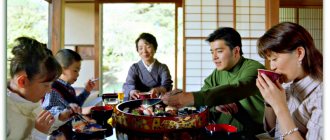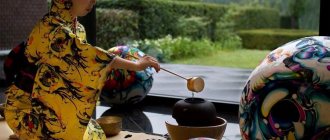Etiquette must be observed even in friendship. Japanese proverb
Japan is a country of high technology, sushi, sakura and Mount Fuji. Its culture is complex and mysterious. Foreigners do not understand why the Japanese allow themselves to smack their lips loudly at the table, do not open the door for women and do not let them forward.
From this article you will learn a lot about Japanese etiquette: how to greet your interlocutor, how to handle chopsticks, how to behave on public transport, etc.
Japanese etiquette is a complex “science”.
Its origins lie in Confucianism, Shintoism, and the strict hierarchical system of Japanese society.
The Japanese are almost always polite and calm. They understand that it is difficult for a European to adapt to their culture, and they treat mistakes in the behavior of tourists with kind irony. That is why a foreigner’s knowledge of Japanese traditions evokes genuine respect from them.
Chopsticks Etiquette
In Japan, there is a certain etiquette associated with chopsticks. When it comes to what you don't want to do, pointing at the other person is at the top of the list. You also don't want to wave them in the air for any reason or spear food with them.
You should also avoid sticking chopsticks into a bowl of rice or passing food between chopsticks, as both of these practices resemble funeral rites. And when you prepare your own food from a shared dish, use the end that you don't put in your mouth to pick up the food.
Tatami etiquette
If you are in a traditional Japanese room, remember: there is only one correct posture for sitting on a tatami (in Japanese it is called seiza , “correct posture”). This is when you sit on your knees with your legs underneath you. Men - only men (!) - can sit cross-legged, but only in a less formal setting. You can also move your legs to the side. Yes, sitting in seiza threatens to turn into torture for an unprepared foreigner. Most likely, your hosts will understand this and will try to take care of you - they will allow you to sit in a more free position or offer you a small bench. However, remember: on the tatami and you cannot stretch your legs in front of you - especially if in this case the toes of your feet will point towards someone present (the toe of your foot is literally the lowest part of your body, and point it insulting to a person). More about “tatami etiquette” . If you know that you will be in a traditional Japanese room (especially if what happens in it will have to do with traditional Japanese arts), be respectful of tradition and try to dress accordingly. This means no jeans, shorts, super minis. Women are strongly advised to wear a sufficiently long skirt. No bare feet - only socks, preferably white (more like traditional Japanese tabi ). The Japanese will most likely not tell you about this, but rest assured, they will appreciate the appropriateness or inappropriateness of your clothing.
It's Actually Normal to Slurp
Slurping is considered extremely bad manners at dinner parties in the West, but in Japan it is standard practice when eating noodles. You'll find that in any restaurant, fellow diners are slurping away as loudly as possible without anyone batting an eyelid.
The Japanese version of "bon appetit", which literally translates to "I'll accept", is i-ta-da-ki-mas. Say this to impress the locals and show them that you made an effort to experience their culture. You can also say oi-shii, which means "delicious" when eating.
Handkerchief
Don't use a handkerchief. The Japanese use thin paper napkins, which we advise you to do too, especially since these paper napkins are distributed completely free of charge at every intersection. In general, it is better not to blow your nose in public at all. According to the rules of good manners, if you have a runny nose, you should sniff until you are alone with yourself, and only then blow your nose. Just don't think this is a joke! The Japanese really do just that. Out of habit, by the way, snooping around is very annoying, but, as you know, you don’t go to someone else’s monastery with your own rules.
Money Doesn't Change Hands
In many countries, the transfer of money from hand to hand is natural. This is rarely done in Japan. When you buy something, you will be given a small tray where you put your money. Likewise, any change will be placed in this tray rather than directly into your hand.
According to Boutique Japan, you'll see this practice everywhere, from shops to cafes and restaurants, train stations and even hotels. Whether you order Starbucks or visit a traditional tea shop, don't forget to keep an eye on your tray!
Place in transport
On the subway, bus and train, no one gives up their seat to anyone - regardless of age and gender. Even if a grandmother enters the carriage - “God’s dandelion”, barely moving her feet, no one, naturally, will move. If you still give up your seat out of pity, then it is quite possible that you will find yourself in a comical situation when this same grandmother, desperately working with her little hands and pushing aside passengers, will follow you and will thank, thank and thank, as if you had done something for her something like that, out of the ordinary. So if you take a seat on a Japanese bus or subway, then sit as long as you like, no matter what ancient old people surround you. Just be careful not to take up a seat for the disabled that is available in subway cars. No one except the elderly and disabled can sit in these seats. You can identify a seat for the disabled by a special pictogram above the seat.
Bowing is the norm
One of the most famous customs in Japan is to bow when greeting rather than shake hands. This may seem a little strange when you're used to shaking hands, and it takes a little getting used to. But especially in the touristy parts of the country, many locals are accustomed to shaking hands to welcome travelers from abroad.
10 most visited places in Japan
Bowing is used not only to greet, but also to thank someone or apologize. Generally, the deeper the bow, the more respect is shown.
Shoes
Don't enter a Japanese house wearing shoes. Street shoes are removed at the entrance. True, for our compatriots there is nothing strange in this - we do the same thing - but for Americans and Europeans it can be difficult to get used to this. Continuation of this rule: do not step on the tatami wearing any shoes at all, not even house slippers. This is the strictest rule of all. For all their tolerance for the oddities of foreigners, the Japanese will not make exceptions for you.
Tipping Only Causes Confusion
In countries like the USA, tipping is the norm. In Japan, it is better not to leave tips in bars and restaurants, as well as in taxis. This only causes confusion. Since it is not part of Japanese culture, a tip will likely be rejected even if the service was phenomenal.
10 facts about Japan that many people don't know
It is also not mandatory to tip your guide while in Japan, but many travelers still feel the need to tip. Although guides are more likely to accept tips, the correct way to do this is to first put the money in an envelope and then hand it to the guide.
Business Cards
Carry business cards with you. This, of course, primarily concerns those who plan to work in Japan, but in general it would be good for everyone to remember this. A business card delivered to the right person at the right time can work wonders. If you don’t have business cards with you, then for the Japanese it looks at least strange. As already mentioned, the use of business cards is not limited to business circles - even students often have them. When a business card is handed to you, you need to take it with both hands, examine it and only then hide it. Don’t just stuff it into your pocket as if you don’t care deeply about what’s written on it. And even more so, do not write anything on the business card that was handed to you.
Don't Pour Yourself a Drink
This is an etiquette tip that is similar to Western rules of conduct. When pouring drinks from a shared bottle during lunch, you must pour drinks for other people at the table. While in the West you tend to pour for others first and then pour for yourself last, in Japan you shouldn't pour for yourself at all.
10 souvenirs you need to bring from Japan
Instead, someone else will pour you a drink. It is not customary to pour yourself a drink. Before drinking in Japan, say something like "Yay!" what is kam-pai?
Present
In Japan, unlike Russia, it is not customary to immediately unwrap gifts that are given to you. The implication is that this is a manifestation of excessive curiosity or greed. In addition, in this way you can make the giver feel ashamed of his modest gift. Such is Japanese delicacy . In Japan - as well as abroad in general - it is customary to give gifts wrapped in wrapping paper. And if all over the world, taking care of the environment, multilayer packaging is abandoned, then in Japan they still strive to wrap everything and everyone as intricately as possible. Traditionally in Japan, gifts were wrapped in white paper and the package was tied with red and white ribbons, which were tied in an intricate knot. Now, of course, it is not necessary to follow this tradition, although you can see such packaging quite often.
The Importance of Silence
Japanese noodle restaurants can be noisy with the food, but quiet is appreciated almost everywhere. In particular, it is considered rude to talk on the phone on public transport. If you are talking to someone else on a bus or train, you are expected to keep your voice down. The idea is to avoid disturbing other passengers.
On public transport you may hear announcements asking you to switch your phone to silent mode. Making any unnecessary noise in public is generally frowned upon.
Eyes to eyes
We have heard the point of view more than once that the Japanese do not like open eye contact. If you try to catch the eye of a Japanese person during a conversation, he becomes embarrassed and shows a desire to end the conversation quickly. Although sometimes the Japanese themselves say that if a person doesn’t look you in the eye, it means he’s hiding something... And yet, in most cases, the Japanese communicate with each other without meeting their eyes. For the Japanese, looking intently into the eyes of your interlocutor is in some sense indecent and means aggressive behavior. When Japanese parents scold their children and the child looks them in the eyes, they especially focus on this, saying: “Well, why are your eyes wide open!!!” Because of this, Japanese children often stand with their eyes downcast when they are scolded. In Russia, on the contrary, at the moment when adults are angry, and children stand and listen to them with their eyes downcast, parents will definitely say: “Why don’t you look me in the eye, probably because you are guilty!!!” The explanation for this unusual custom takes us to medieval Japan, in whose life everything was strictly regulated. For example, looking into the eyes of a person with a higher social status was considered simply arrogance, and in those days one could easily pay with one’s life for such an act. Of course, that social structure became a thing of the past with the end of the Edo era, but it left a deep mark on the psychology of the Japanese right up to the present day. Apparently, this is why the Japanese subconsciously try to avoid making eye contact with their interlocutor . We would not classify “looking into the eyes” as an unambiguous prohibition, but, on the other hand, this should be remembered.
If You're Staying with a Local, Bring a Gift
If you are staying with locals while in Japan, it is polite to bring a small gift from your home country. We would greatly appreciate it, as gift-giving is a common practice in Japan, usually done in particular to celebrate the change of season and moving to another home.
Bring simple souvenirs, chocolates and other items only available in your country, rather than expensive, eccentric or showy gifts. Anything too bright is considered to be in poor taste. In Japan, gifts are also given and received with two hands rather than one.
In a Japanese house
The Japanese rarely invite guests to their home, not because of a lack of hospitality, but, as a rule, because of the lack of free space in which to comfortably receive guests. Therefore, if you are lucky and are invited to a Japanese home, take note of several points of Japanese etiquette regarding visiting and behavior in a Japanese home . When entering a Japanese home , say hello, bow, take off your shoes in the hallway /' genkan '/ and put on the slippers offered to you. It is not customary to arrive empty-handed. Be sure to take a small souvenir with you (a bottle of wine or whiskey, caviar, or a traditional souvenir from your country would be a good gift. It is not customary to give flowers, knives, or combs) and hand it over as soon as you enter the house. Even if the interior of a Japanese house is decorated in a European style, there will definitely be at least one room in a traditional Japanese style with an alcove /' tokonoma '/, decorations in it - ikebana and a bundle painting / ' kakemono '/, and a floor covered straw mats “tatami” measuring 180 x 90 cm each. Before entering this room, it is customary to remove slippers so as not to damage the material from which the tatami .
Bath Slipper Bargain
When visiting ryokans and traditional Japanese gastropubs called izakayas, you will find that there are slippers specifically designed for use in the bathroom. There is a certain etiquette here. Do not leave bath slippers outside the bathroom and wear bath slippers while in the bathroom.
Always remember to put your non-bathroom slippers back on when you leave the bathroom. According to Boutique Japan, if you don't (and many tourists tend to forget), you may be greeted with gentle laughter when you return to your table!
Types of greetings
Throughout the day, Japanese people use different phrases to greet each other. If you say “good evening” instead of “good morning”, you may be considered uncultured and rude.
The Japanese greeting depends on the time of day, the relationship between the speakers and their social status:
- Until 10:00 ohayo is said, but this greeting is informal. For more polite treatment, gozaimas are added. Interestingly, actors and media professionals use this greeting throughout the day, historically.
- During the day they use konnichiwa. This appeal can be used throughout the day, especially for foreigners.
- After 18:00 and before midnight they greet by saying konbanwa.
- Then until 6:00 they say the phrase oyasuminasai (oyasUmi nasai). In close relationships, it is permissible to use the abbreviation oyasumi. This phrase is also used to wish “good night” and “good dreams.”
If you are not sure whether to be formal in a conversation, you need to remember one rule: in the Land of the Rising Sun there is no concept of “too much politeness.” Formality in communication will be well received by your interlocutor.
Traditional Japanese greeting when meeting someone
If you are introduced to a person for the first time, the greeting rules are somewhat different from the usual ones. First of all, after indicating your own name, you should say hajimemashite (hajimemAshte). The “ji” in a word must be pronounced softly, and for a Russian-speaking person the very idea of a softened “zh” may seem strange.
This phrase can be translated as “nice to meet you” and expresses friendliness. After this, you can briefly introduce yourself to find topics for conversation. However, before this, you need to inquire about the health of your interlocutor by asking o genki des ka (about genki des ka). If you were asked this question, then you should answer genki desu (genki des) - “Everything is fine” or maa-maa desu (ma-ma des) - “It will do.” You should say this even if you are not doing very well. Complaining about problems is only permissible if you have a very close relationship with your interlocutor.
Having answered this question, you need to inquire about the state of your interlocutor, saying anata wa (anAta wa) - “What about you?” Listen carefully to the answer before starting an acquaintance.
When saying goodbye to a new acquaintance, it is best to use the phrase yoroshiku onegaishimasu (yoroshiku onegaishimas). The most accurate translation of this phrase sounds like “please take care of me,” which is quite unusual for a European.
Eating food
Before starting dinner, in a Japanese restaurant it is customary to wipe your hands with special wet towels - oshibori. If several people are sitting at a table, no one should start eating before everyone's orders have been served. At the beginning of dinner, the phrase “itadakimasu” is said, which means “I accept with gratitude.”
In any cuisine there are dishes that should be tasted immediately after serving, and Japanese cuisine is no exception. If one of those present ordered such a dish and it was already served, but the rest have not yet been brought anything, then you can start tasting. However, before doing this, it won’t hurt to say the phrase “o-saki-ni itadakimas”, which translated means “let me start first”, and the answer to this will be “o-saki-ni do:zo” - “please start”.
It is better to bring a small plate closer to your mouth while eating, but wide and deep dishes should be left on the table. An izakaya (Japanese version of a diner or inn) often serves food on a shared plate. It is more correct to take pieces of food from such a plate with chopsticks specially designed for passing food or with the reverse side of ordinary chopsticks.
It is considered good manners to eat the entire contents of the plate “to the last crumb.” When a dish contains foods that you do not want to eat, you can ask the staff in advance not to add these ingredients to the order. In extreme cases, when it was not possible to warn the cook, and foods that were undesirable for the guest ended up on the plate, they can, of course, be left. But bad behavior includes burping or blowing your nose at the table.
It is considered good manners to end a meal to return all items to their places. For example, bowls that were served with lids should be covered again, and the chopsticks should be placed where they originally lay. This can be a paper lining or a special stand.
In Japan, they respect not only those who prepare food, but also the products themselves. Therefore, after finishing dinner, you can say the phrase “gochiso: sama deshita” - an analogue of the usual “thank you”. In this way, guests will express their appreciation to both the chef and the ingredients of the dinner.










